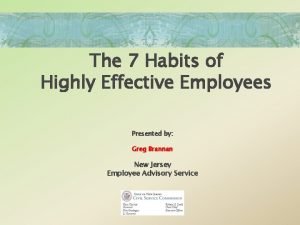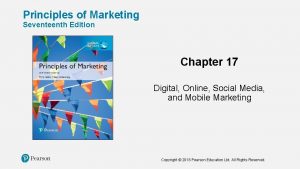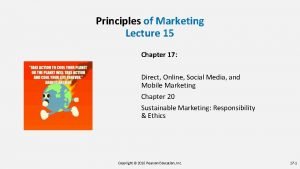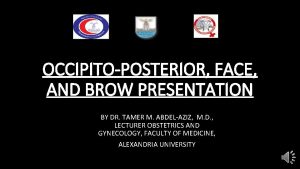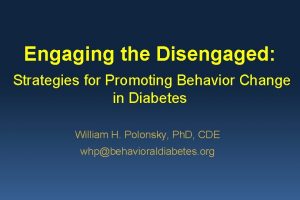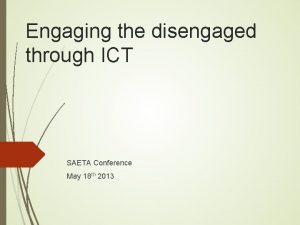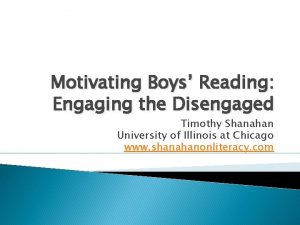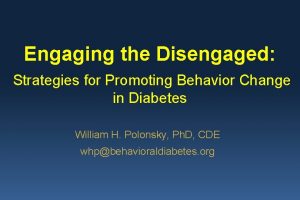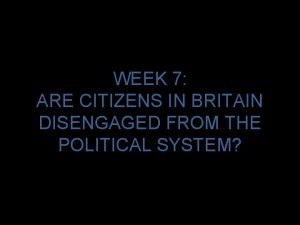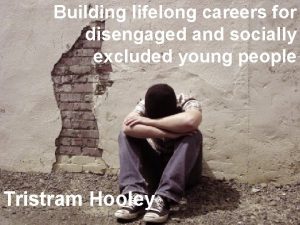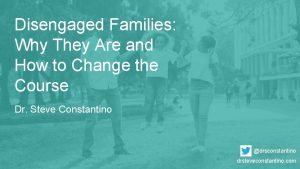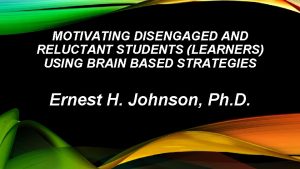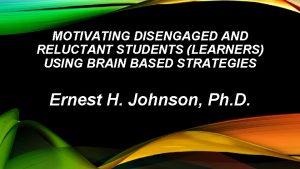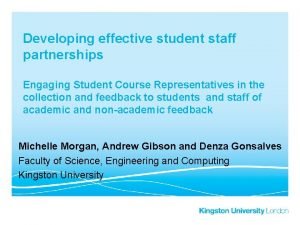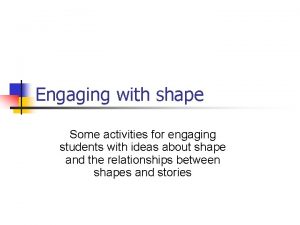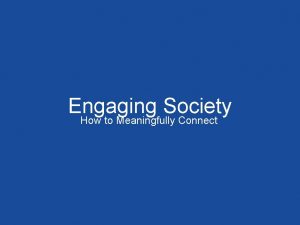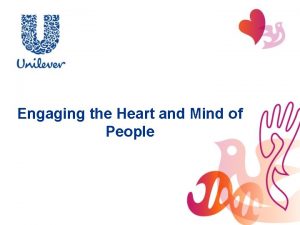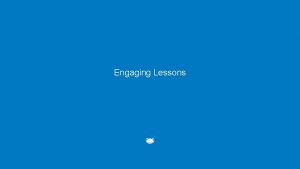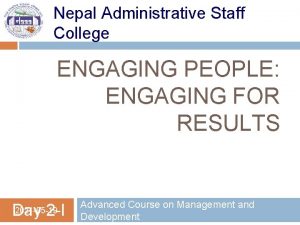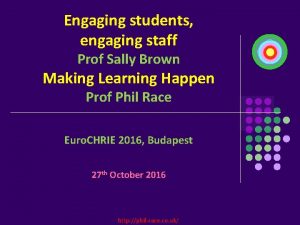Engaging the Disengaged Student Engaging the disengaged student



































- Slides: 35

Engaging the Disengaged Student

Engaging the disengaged student Melissa Bosomworth (MA, PCC) Wellness Coach Durham College Sue Hawkins (MA) Manager, School College Work Initiative & Academic Upgrading Durham College


Engaging the disengaged student - Missing class Not participating Sleeping in class Missed homework Lack of eye contact Lack of personal hygiene No friends Tone of voice Closed body language

Engaging the disengaged student How do we engage the disengaged student?


Engaging the disengaged student • Engagement is connected to motivation • To be intrinsically motivated psychological needs of autonomy, competence, relatedness and relevance need to be met If you see a lack of engagement, there might be a lack of motivation which means psychological needs are not being met

Engaging the disengaged student Lack of Engagement Not motivated Psychological needs not met

Engaging the disengaged student Lack of Engagement Not motivated Social determinates of health: - Income - Aboriginal Status - Education - Gender - Employment - Race - Food Insecurity - Disability - Housing - Social Exclusion - Social Safety Network - Health Services - Early Childhood Development

Engaging the disengaged student

Engaging the disengaged student Lack of Engagement Not motivated - Durham Region: 37% homeless population children & youth (higher than national average) - Food insecurity - Violence in home - Substance experimentation and misuse - Development of mental illness (75% develop before the age of 24) - Lack of meaning, purpose and direction in life


Engaging the disengaged student “When I was little, my teachers would ask me about my hopes, dreams and goals but those were a privilege my family did not have. My mother never once told me I could be anything I wanted to be; she told me I needed to make money to put food on the table. ” ~ CFS Student

Engaging the disengaged student Lack of Engagement Not motivated Psychological needs not met

Engaging the disengaged student nt e m e g a g En

Engaging the disengaged student So, how do we engage the disengaged student?

Engaging the disengaged student Dual credit programs help access community supports

Engaging the disengaged student Teacher

Engaging the disengaged student Focus should be on building a relationship with students, to help develop a sense of belonging, so they can start to develop Esteem (accomplishment- GED), and then intrinsic motivation will start to grow and students will be engaged with their learning connection>belonging>esteem (accomplishment)>motivation>engagement

Engaging the disengaged student Not about preparing for “the real world” Not about preparing for college

Engaging the disengaged student It’s all about the Connection

Engaging the disengaged student • Connection is a common theme for engagement & motivation….

Engaging the disengaged student

Engaging the disengaged student • Connection is why we are here • Shame unravels connection • For connection, we need to allow ourselves to be seen (vulnerability) • Sense of belonging came from a belief that you are worthy for love & belonging Teachers need to INSPIRE students to believe they are worthy of love and belonging

Engaging the disengaged student Next steps… • Invest in discovering how to inspire the belief of worthiness • Restorative practice to reduce shame & increase vulnerability

Engaging the disengaged student

Engaging the disengaged student • Brene Brown’s TED talk spoke to core as a teacher and human being • ‘Teaching is a Work of Heart’ • “The restorative work that I am engaged in and advocating in schools is very much influenced by the intention of living ‘whole-heartedly’, of being vulnerable, authentic. It is along this path where we meet connection, where we find our true selves and see this in one another” • Restorative Practices in the classroom Embrace fears Acknowledging and opening up to shame Cultivating the power of vulnerability

Engaging the disengaged student Use affective statements I statements that express an emotion/affect The intention is to share in a way that promotes empathy and understanding Challenging for teachers whose identity of a good teacher was attached to being or feeling the need to be authoritarian and in total control International Institute for Restorative Practices https: //www. iirp. edu/

Engaging the disengaged student “restorative practices may just be our Yellow Brick Road”

Engaging the disengaged student

Engaging the disengaged student Reflection questions 1. What does it mean to be vulnerable as a teacher? 2. How can you cultivate vulnerability in your classroom? 3. How can you utilize restorative practices in your classroom?




Engaging the disengaged student Melissa Bosomworth (MA, PCC) Wellness Coach Durham College Melissa. bosomworth@durhamcollege. ca Sue Hawkins (MA) Manager, School College Work Initiative & Academic Upgrading Durham College Sue. Hawkins@durhamcollege. ca
 7 habits of highly effective employees
7 habits of highly effective employees Engaging dynamics
Engaging dynamics Marketing involve engaging directly with carefully targeted
Marketing involve engaging directly with carefully targeted Marketing involve engaging directly with carefully targeted
Marketing involve engaging directly with carefully targeted Fundal grip
Fundal grip Tư thế ngồi viết
Tư thế ngồi viết Thứ tự các dấu thăng giáng ở hóa biểu
Thứ tự các dấu thăng giáng ở hóa biểu Voi kéo gỗ như thế nào
Voi kéo gỗ như thế nào Thẻ vin
Thẻ vin Thơ thất ngôn tứ tuyệt đường luật
Thơ thất ngôn tứ tuyệt đường luật Từ ngữ thể hiện lòng nhân hậu
Từ ngữ thể hiện lòng nhân hậu Sự nuôi và dạy con của hổ
Sự nuôi và dạy con của hổ Thế nào là hệ số cao nhất
Thế nào là hệ số cao nhất Diễn thế sinh thái là
Diễn thế sinh thái là Vẽ hình chiếu vuông góc của vật thể sau
Vẽ hình chiếu vuông góc của vật thể sau 101012 bằng
101012 bằng Lời thề hippocrates
Lời thề hippocrates Vẽ hình chiếu đứng bằng cạnh của vật thể
Vẽ hình chiếu đứng bằng cạnh của vật thể Tư thế worms-breton
Tư thế worms-breton đại từ thay thế
đại từ thay thế Quá trình desamine hóa có thể tạo ra
Quá trình desamine hóa có thể tạo ra Công thức tính thế năng
Công thức tính thế năng Sự nuôi và dạy con của hổ
Sự nuôi và dạy con của hổ Thế nào là mạng điện lắp đặt kiểu nổi
Thế nào là mạng điện lắp đặt kiểu nổi Các châu lục và đại dương trên thế giới
Các châu lục và đại dương trên thế giới Dot
Dot Bổ thể
Bổ thể Biện pháp chống mỏi cơ
Biện pháp chống mỏi cơ độ dài liên kết
độ dài liên kết Thiếu nhi thế giới liên hoan
Thiếu nhi thế giới liên hoan Chúa sống lại
Chúa sống lại điện thế nghỉ
điện thế nghỉ Một số thể thơ truyền thống
Một số thể thơ truyền thống Trời xanh đây là của chúng ta thể thơ
Trời xanh đây là của chúng ta thể thơ Sơ đồ cơ thể người
Sơ đồ cơ thể người
